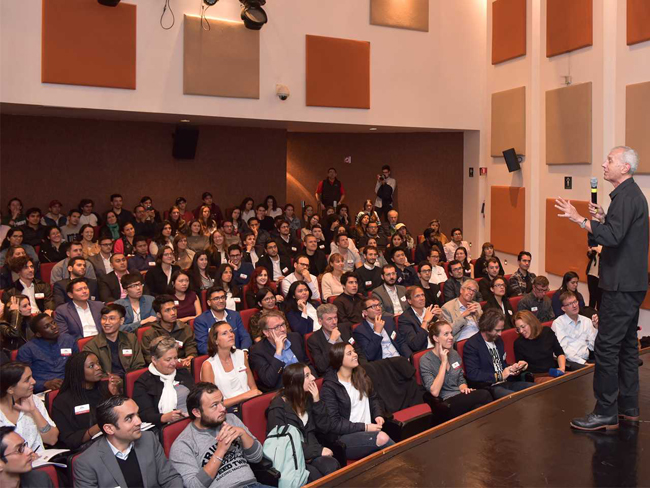
More than 50 young architects and engineers participated in the recent international
The first LafargeHolcim Research in Practice Grant (RPG) recipients were announced by Marilyne Andersen and Harry Gugger, both members of the Board of the LafargeHolcim Foundation and professors at the Swiss Federal Institute of Technology (EPFL Lausanne). Harry Gugger explained that the core aim of the RPG program is to mentor and financially support emerging professionals to conduct leading edge, practice-related research in the field of sustainable construction. “The grants are a vital support for developing the knowledge needed to proactively meet the challenges facing the materials industry and the built environment,” added Marilyne Andersen.
A grant was conferred upon Heidi Boulanger (van Eeden), University of Pretoria (South Africa), to pursue her research on integrating production facilities for construction material into rural communities, creating new urban nodes. Stefano Romagnoli, Juan Cruz, and Tomás Pont, Universidad Nacional de Córdoba (Argentina), will use their grant to advance an infrastructure-landscape project for the generation of electric power by harnessing tidal currents. Nada Nafeh, American University in Cairo (Egypt), will further develop an approach to improve living conditions in informal settlements; her vision has the potential to transform architecture from the “design of products” to the “design of processes.”
The Next Generation Awards Lab participants had previously been selected as prize-winning teams of the five regional Awards competitions in 2017 run by LafargeHolcim, the French-Swiss global building materials giant. The Lab offered a platform to further develop cutting-edge projects and exchange visionary ideas on the future of sustainable construction. The concurrent workshops across scales from micro to macro were moderated by members of the Academic Committee (AC) of the LafargeHolcim Foundation, supported by the Global LafargeHolcim Awards winners 2018, faculty members of IBERO, and members of the Board of the Foundation.
The Lab event on Thursday 6 September 2018 included an introduction by Marc Angélil, professor at the Swiss Federal Institute of Technology (
Tatiana Bilbao showed how an interdisciplinary team proposed and realized a large number of small architectural interventions for the botanical gardens in Culiacán, Sinaloa State in Mexico. The project is the embodiment of “doing more with less” to create areas to rest and for encountering the space, engaging people by combining art, recreation and education. She also explained her current research work on “the house”, mentioning how important it is for architects to create a platform for people to live their own lives and not imposing their personal ideas upon them.
“It’s not about building, but about interaction and having a positive impact on society,” explained Michel Rojkind. He showed the example of Fora Boca, a concert hall in Boca del Río, Veracruz State in Mexico that reconnects a formerly neglected area with the community. “We went beyond the standard program of design and experimented with innovation to achieve social reconstruction by creating open spaces and possibilities for interaction,” he added.
Roland Köhler (Switzerland), chairman of the Board of the LafargeHolcim Foundation, noted that over half of all entries submitted in the current LafargeHolcim Awards for Sustainable Construction were by individuals and teams up to 30 years of age – and the competition now boasted more than 5,000 submissions. “It is exciting that the Awards competition has been embraced by ‘tomorrow’s names in the industry’; and that the Next Generation prize winners joined the Awards Lab at IBERO to expose their work to peers and professionals, build an international network and apply for grants,” said Köhler.
The next competition – the 6th International LafargeHolcim Awards for Sustainable Construction – opens for entries in mid-2019 at %$Linker:






